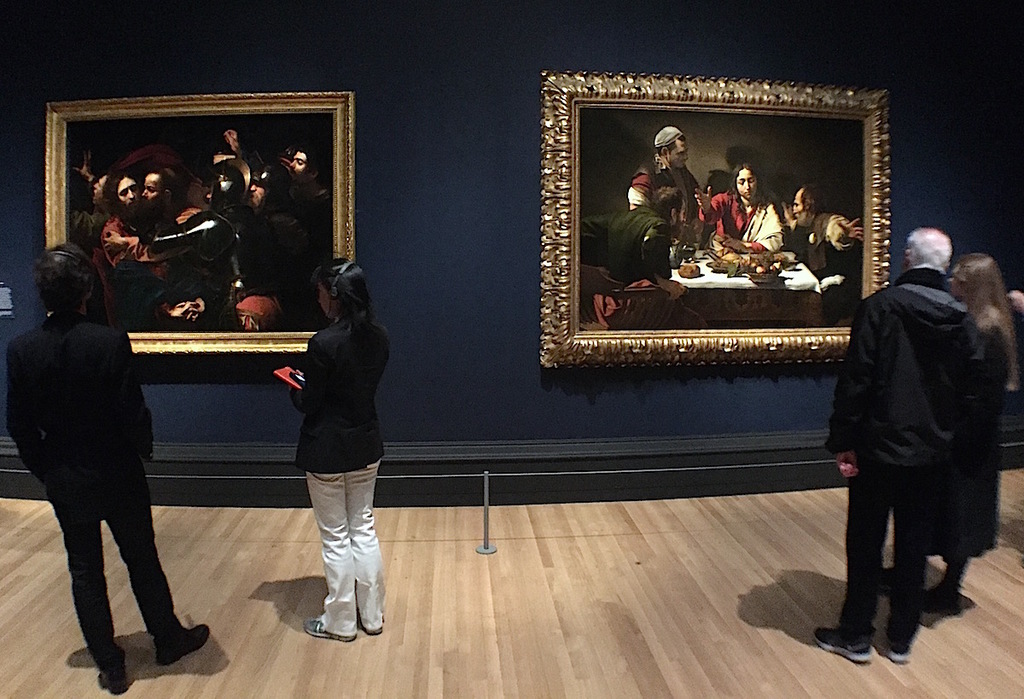The new Beyond Caravaggio show in the sepulchral depths of the new wing of the National Gallery deserves to draw a large and enthusiastic public and will in all probability do so. Since most of the items on view are in fact quite large, going to see it won’t be the jostling struggle that prevailed at the Leonardo show of not so long ago, though Caravaggio nowadays is almost as big a name with the wider public, for whom only a few museum exhibitions are must-see events.
That public, however, may perhaps be disappointed to discover that there are only six, out of fifty, paintings by Caravaggio actually present, and that only four of these are in British collections – three in that of the National Gallery itself, and one more, rather small and inconsiderable, that comes from the collection of H.M. the Queen. Quite a few of the other pictures on view have been wrongly attributed to Caravaggio at one time or another.
The point is that Caravaggio has embedded himself in folk memory in a way that has been given to few other artists. If Leonardo was a magus, Caravaggio is the pre-eminent bad boy of art, with a life story dramatic enough to satisfy anyone – he revolutionized the art of his time, had to flee from Rome because he had killed someone in a brawl, became (though not of noble stock) a Knight of Malta, had to flee again, and finished up dying of sunstroke as he raged on a deserted beach, attempting to make his way back to the Rome that had thrown him out.
He is also a populist, who still has the power to make the visual arts panjandrumate feel extremely uneasy. The story of Caravaggio paintings in Britain is very much a story of missed opportunities – often ones that were willfully missed. The catalogue of the show has the good grace to come clean about much of this. In particular, it offers in some detail the story of how the National Gallery’s late period Caravaggio of Salome Receiving the Head of John the Baptist was forced into the permanent collection in 1969 (after having been on loan there since 1961), over the objections of the then Director, Martin Davies. His successful opponent was the collector and notable 17th-century specialist, Denys Mahon, then serving as a Trustee, who won by one vote.
this is a high quality show, which raises a lot of issues, while at the same time offering (to me at least) a high ratio of visual stimulation and enjoyment.
A notable masterpiece that got away, after a brief sojourn in Britain, and which is now on loan to the show, is the large Saint John the Baptist, at Burton Constable with the Chichester-Constable family from 1908 to 1951, but then sold through Agnew’s to the Nelson Atkins Museum of Art in Kansas City. Since most of us will not make our way to Kansas City for the purpose of looking at art, this exhibition offers a great opportunity to see it.
Mysterious, in the same context, is the absence of a second version of Caravaggio’s earlier masterpiece The Cardsharps, once in Mahon’s own collection, acquired during the closing years of his long life. The better-known version, itself previously discovered by Mahon, is at the Kimbell Museum in Fort Worth, Texas. The second version is subtly different from the first – the viewpoint is placed a little lower. Many Caravaggio specialists believe the attribution; others doubt it. Having seen the painting myself when it was exhibited in Italy, I am, though strictly a non-specialist, inclined to say ‘yes’. It would be nice if it had come up for judgment again in this context, especially since it is still not only here in Britain, but actually in London. After Mahon’s death, the picture was offered on loan to the Ashmolean Museum, which timorously refused. It is now in exile at the Museum of St John in Clerkenwell – not much of a distance away physically from the National Gallery. It’s a situation that offers a parallel in a way to Caravaggio’s own stormy biography.
Though Caravaggio’s massive personality, and the problems associated with his work, tend to throw the other artists whose work is on display in the shade, this is a high quality show, which raises a lot of issues, while at the same time offering (to me at least) a high ratio of visual stimulation and enjoyment.
Among the issues, well worth thinking about, are first the role of populism in art (panjandrums instinctively tend to think that populism is vulgar, and though Caravaggio is long gone from this world he continues to disturb them). And secondly, the fallibility of supposedly expert attributions. Read the catalogue carefully, and you’ll be amazed, not only by the fact that some of the attributions are to artists whose real names and personalities remain unknown, even to experts, but also by how much the known names have skittered about, hopping from picture to picture. Now you see me. Now you don’t.
Beyond Caravaggio at National Gallery 12 October 2016 – 15 January 2017
Words: Edward Lucie-Smith

